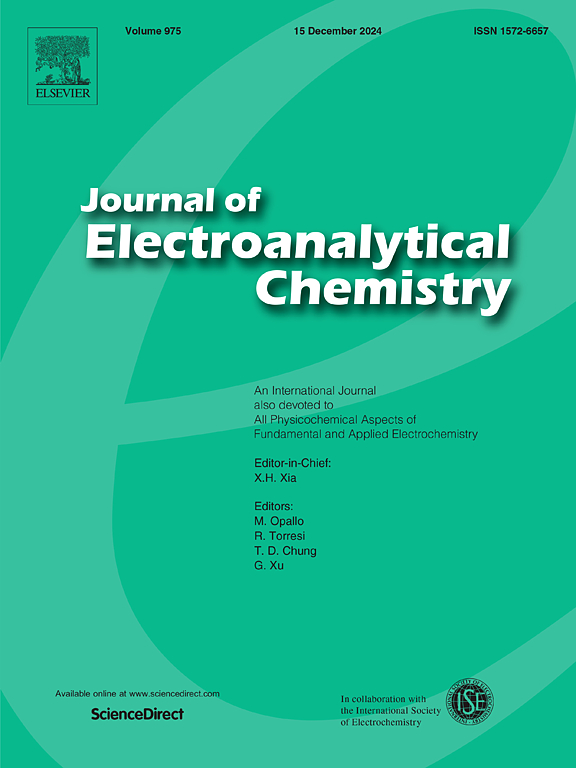Adsorption of iodide ions at the Bi(111)| trimethyl phosphate interface
IF 4.1
3区 化学
Q1 CHEMISTRY, ANALYTICAL
引用次数: 0
Abstract
The adsorption of I− anions on the Bi(111) single crystal plane from trimethyl phosphate has been investigated with impedance measurements. Both electrode charge and electrode potential were applied as the independent electrical variables in the calculations of the ionic charge due to the specific adsorption following the mixed-electrolyte method. It was found that under comparable conditions, the values of specific adsorption charge calculated at constant electrode charge and electrode potential, are practically coincident. The Gibbs energy of I− anions adsorption has been calculated using the virial adsorption isotherm. It was found that the standard Gibbs energy of I− anion adsorption is lower than in the other solvents studied earlier (acetonitrile, gamma-butyrolactone and various carbonates). However, the specific adsorption charge values of iodide ions in trimethyl phosphate depends more from relative concentration of I− ions in the solution than for other systems. This corresponds to lower lateral repulsion coefficient values, calculated from the virial isotherm. The electrosorption valency values have been calculated and it was found that this parameter is higher in trimethyl phosphate than in other studied organic solvents.
通过阻抗测量研究了磷酸三甲酯在 Bi(111) 单晶平面上对 I- 阴离子的吸附。在按照混合电解质法计算因特定吸附而产生的离子电荷时,电极电荷和电极电位都被用作独立的电学变量。结果发现,在可比条件下,电极电荷和电极电位恒定时计算出的比吸附电荷值实际上是一致的。利用维里亚尔吸附等温线计算了 I- 阴离子吸附的吉布斯能。结果发现,I 阴离子吸附的标准吉布斯能低于之前研究的其他溶剂(乙腈、γ-丁内酯和各种碳酸盐)。不过,与其他体系相比,碘离子在磷酸三甲酯中的特定吸附电荷值更多地取决于溶液中碘离子的相对浓度。这与根据virial等温线计算出的较低横向斥力系数值相对应。计算电吸附价后发现,磷酸三甲酯中的电吸附价高于其他研究过的有机溶剂中的电吸附价。
本文章由计算机程序翻译,如有差异,请以英文原文为准。
求助全文
约1分钟内获得全文
求助全文
来源期刊
CiteScore
7.80
自引率
6.70%
发文量
912
审稿时长
2.4 months
期刊介绍:
The Journal of Electroanalytical Chemistry is the foremost international journal devoted to the interdisciplinary subject of electrochemistry in all its aspects, theoretical as well as applied.
Electrochemistry is a wide ranging area that is in a state of continuous evolution. Rather than compiling a long list of topics covered by the Journal, the editors would like to draw particular attention to the key issues of novelty, topicality and quality. Papers should present new and interesting electrochemical science in a way that is accessible to the reader. The presentation and discussion should be at a level that is consistent with the international status of the Journal. Reports describing the application of well-established techniques to problems that are essentially technical will not be accepted. Similarly, papers that report observations but fail to provide adequate interpretation will be rejected by the Editors. Papers dealing with technical electrochemistry should be submitted to other specialist journals unless the authors can show that their work provides substantially new insights into electrochemical processes.

 求助内容:
求助内容: 应助结果提醒方式:
应助结果提醒方式:


